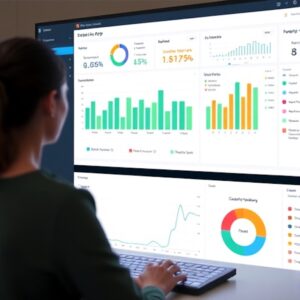We live in a world where data rules, and businesses are no different. Many still use old ways to track their KPIs, leading to waste and wrong data. Custom KPI Tracking Systems can change this. They help businesses work better and make smarter choices.
Custom KPI Tracking Systems and Business Efficiency tools are key for staying ahead. They help spot where to get better, set achievable goals, and see how far they’ve come.
Introduction to Custom KPI Tracking
This article will dive into the perks of Custom KPI Tracking Systems. We’ll see how they boost business efficiency. We’ll also look at how these systems help businesses make better choices.
Key Takeaways
- Custom KPI Tracking Systems can help businesses improve their efficiency and productivity
- These systems provide accurate and timely data, enabling businesses to make informed decisions
- Custom KPI Tracking Systems can help businesses identify areas of improvement and set realistic goals
- Business Efficiency tools are essential for businesses to stay competitive in today’s market
- Custom KPI Tracking Systems can help businesses track their progress over time and make adjustments as needed
- Implementing Custom KPI Tracking Systems can lead to increased business efficiency and productivity

What Are Custom KPI Tracking Systems?
Custom KPI tracking systems help organizations watch and understand their performance. They use special software to track important metrics. This gives insights that help in making better business choices.
These systems offer real-time data and analytics. This means businesses can quickly see and act on changes. They also work with other systems, like CRM or ERP, for a full view of performance.
Definition and Importance
Custom KPI tracking systems are made for each organization’s needs. They are key because they let businesses track and analyze their performance in a way that matters. This helps find areas to improve and make choices based on data.
How They Differ from Standard Systems
Custom KPI systems are made for specific needs, unlike standard systems. Standard systems might not give the detail needed. Custom systems are also more flexible, allowing for changes as needed.
- Real-time data and analytics
- Customizable dashboards and reports
- Integration with other business systems
- Ability to track and analyze performance metrics
Using custom KPI systems helps businesses understand their performance better. They are a key tool for improving performance and reaching goals.
Benefits of Custom KPI Tracking Systems
We will talk about the good things about custom KPI tracking systems. These include better data, smarter decisions, and more team responsibility. With Key Performance Indicators software, companies can track their Business Performance well and make choices based on data.
Some main benefits of custom KPI tracking systems are:
- Enhanced data accuracy, which helps businesses make smart choices
- Improved decision making, leading to more work done and better efficiency
- Increased team accountability, causing better teamwork and talking among team members
By using a custom KPI tracking system, companies can learn a lot about how they’re doing. They can change things if needed. This is done with Key Performance Indicators software, which gives a full view of Business Performance.
Custom KPI tracking systems bring many benefits to businesses. These include better data, smarter choices, and more team responsibility. By using Key Performance Indicators software and focusing on Business Performance, companies can grow and succeed.
| Benefits | Description |
|---|---|
| Enhanced data accuracy | Enables businesses to make informed decisions |
| Improved decision making | Leads to increased productivity and efficiency |
| Increased team accountability | Results in better collaboration and communication among team members |
Key Features to Look For
When picking a custom KPI tracking system, look for certain key features. We’ll talk about the importance of real-time data, easy-to-use interfaces, and how well they integrate with other systems. These are key to making sure the KPI dashboard software and analytics platform fit your organization’s needs.
A top-notch KPI dashboard software should let you see data in real-time. This way, you can keep up with performance metrics as they change. It’s also important for the interface to be easy to use. This makes sure everyone can understand and work with the data without hassle.
Real-Time Data Access
Real-time data access is a must-have for any KPI dashboard software. It lets you watch performance metrics as they happen. This means you can quickly adjust to changes in the market or within your own operations.
User-Friendly Interface
A user-friendly interface is key. It makes sure everyone can easily get around and understand the data. This is super important in a KPI analytics platform. It lets users focus on analyzing and making sense of the data, not getting stuck on how to use the system.
Some important features to look for in a KPI analytics platform include:
- Real-time data access
- User-friendly interface
- Integration capabilities with other systems and tools
By looking at these features, you can find a KPI dashboard software and analytics platform that really works for you. This will help you reach your goals.
How to Identify the Right KPIs
Finding the right KPIs is key for businesses to make smart choices. We need to match KPIs with our goals and get everyone involved. This makes sure we all aim for the same things.
Good data-driven decision making means tracking and analyzing the right KPIs. With Performance Monitoring tools, it’s easier to spot where we can get better and tweak our plans.

Aligning KPIs with Business Goals
To match KPIs with our goals, we must know what we aim for. This could be making more money, pleasing our customers, or cutting costs. With clear goals, we can pick the KPIs that show us how we’re doing.
Involving Stakeholders in KPI Selection
Getting everyone involved in picking KPIs is crucial. This includes our team, managers, and top leaders. Working together helps us pick the best KPIs and makes everyone feel responsible.
- Relevance: Is the KPI aligned with our business goals?
- Measurability: Can we accurately track and measure the KPI?
- Actionability: Can we take action based on the KPI data?
| KPI | Business Goal | Performance Monitoring Tool |
|---|---|---|
| Revenue Growth | Increase Revenue | Financial Analytics Software |
| Customer Satisfaction | Improve Customer Experience | Customer Feedback Platform |
| Cost Reduction | Reduce Expenses | Expense Tracking Software |
Steps to Implement a Custom KPI System
Setting up a custom KPI system is key to boosting business efficiency. We’ll cover the main steps, like planning, choosing software, and training your team. These steps help businesses create a system that fits their specific needs and goals.
The first step is planning and design. Here, we pick KPIs that match our business goals. We look at our current processes and choose metrics that will help us succeed. Then, we pick the best KPI software that fits our needs and budget.
Planning and Design Phase
In this phase, we set up our KPIs and how to track them. This includes:
- Identifying key business objectives
- Defining relevant KPIs
- Establishing targets and thresholds
Software Selection
When choosing KPI software, we look at several things. These are:
- Customization options
- Data integration capabilities
- User-friendly interface
Training Your Team
Lastly, we train our team on the new KPI system. This ensures they know how to use the software and track KPIs well. This includes:
- Software training sessions
- Onboarding and support
- Ongoing evaluation and feedback
By following these steps and using the right KPI software, we can make a custom KPI system. This system will drive business success and help us reach our goals.
Real-World Examples of Successful KPI Implementation
We’ve talked about how important KPI tracking systems are for better business efficiency. Now, let’s see some real examples of KPI success. Companies across different industries have seen big benefits from using Business Efficiency tools to track their Performance Metrics.

Case Study: Manufacturing Sector
In the manufacturing world, companies use KPIs to watch over production efficiency, inventory, and supply chain. With Business Efficiency tools, they spot where they can get better and make smart choices to boost productivity and cut costs.
Case Study: E-commerce Business
E-commerce sites use KPIs to keep an eye on website visitors, conversion rates, and customer happiness. By tracking Performance Metrics, they fine-tune their marketing, enhance customer service, and grow their sales.
Some key perks of KPI use include:
- Smarter decision making
- More team responsibility
- Better data accuracy
With Business Efficiency tools and Performance Metrics tracking, companies get deep insights into their operations. This helps them make wise choices to grow and improve.
| Industry | KPIs Used | Benefits |
|---|---|---|
| Manufacturing | Production efficiency, inventory levels | Increased productivity, reduced costs |
| E-commerce | Website traffic, conversion rates | Improved customer experience, increased sales |
Challenges of Custom KPI Tracking Systems
Businesses often face challenges when they set up custom KPI tracking systems. One big issue is data overload. This happens when there’s too much data to handle, making it hard to find the most important KPIs. Key Performance Indicators software helps by giving a clear view of the data.
Another problem is getting employees to accept change. New KPI dashboard software can be met with doubt. It’s key to address these concerns and train employees well. The right KPI dashboard software can make the transition easier and more understandable for everyone.
Some common issues with custom KPI tracking systems include:
- Data overload and trouble finding key performance indicators
- Employees’ resistance to change
- Choosing the right Key Performance Indicators software and KPI dashboard software
By understanding and tackling these challenges, businesses can make their custom KPI tracking system work well. This ensures they get the most out of their Key Performance Indicators software and KPI dashboard software.
Tools and Technologies for Custom KPI Tracking
We use many tools and technologies for custom KPI tracking. This helps businesses measure their performance well. It’s key for them to see how they’re doing and make smart choices.
A KPI analytics platform gives a full view of important performance indicators. It helps make decisions based on data.
Popular Software Solutions
Some top software for tracking KPIs include:
- Tableau
- Power BI
- Google Data Studio
These tools offer easy access to data, simple interfaces, and can connect with other systems. They make tracking and analyzing KPIs simpler.
Emerging Technologies in KPI Tracking
New tech like artificial intelligence and machine learning are being added to KPI platforms. This helps businesses understand their performance better and predict future outcomes more accurately.
By using these tools and technologies, companies can better measure their business performance. They can make decisions based on data to grow and succeed.
| Tool | Features | Benefits |
|---|---|---|
| Tableau | Real-time data access, user-friendly interface | Enhanced data analysis and visualization |
| Power BI | Integration capabilities, machine learning integration | Improved predictive analytics and decision-making |
| Google Data Studio | Collaboration features, customizable dashboards | Streamlined data sharing and communication |
Measuring the Success of Your KPI System
To check if your KPI system works, you need a way to evaluate it. This means setting goals and watching how your strategy changes. Using data-driven decision making helps you make smart choices that grow your business.
It’s key to use Performance Monitoring tools to see how you’re doing and where you can get better. These tools give you important info about your performance. This lets you tweak your plan to get better results. Important steps for success include:
- Setting realistic and achievable targets
- Establishing a regular review process
- Encouraging a culture of transparency and accountability
By focusing on data and using Performance Monitoring tools, your KPI system will meet your business goals. Keeping an eye on your strategy and making adjustments as needed will help you succeed in the long run.
The Role of Leadership in KPI Tracking
Effective leadership is key to success in Custom KPI Tracking Systems. Creating a culture of accountability is vital for Business Efficiency tools to flourish. Leaders set clear goals and expectations, driving teams towards common objectives and business growth.
Leaders must explain the value of KPIs to their teams. This ensures everyone sees how their work helps the company succeed. Regular feedback, coaching, and recognition motivate teams, boosting performance and efficiency.
Creating a Culture of Accountability
To build a culture of accountability, leaders should:
- Set clear and measurable goals
- Provide regular feedback and coaching
- Recognize and reward outstanding performance
- Encourage open communication and transparency
These strategies empower team members to own their work and aim for excellence. This leads to better performance, efficiency, and decision-making. All these are crucial for successful Custom KPI Tracking Systems.
Communicating KPI Importance to Teams
Effective communication is essential for teams to grasp KPI importance. Leaders should:
| Communication Strategy | Benefits |
|---|---|
| Regular team meetings | Encourages open discussion and feedback |
| Clear goal-setting | Ensures everyone is working towards a common objective |
| Recognition and rewards | Motivates team members to perform at their best |
By communicating KPI importance and fostering accountability, leaders can maximize their Custom KPI Tracking Systems. This drives business efficiency and growth.
Future Trends in KPI Tracking Systems
We’re seeing big changes in how businesses track KPIs. Companies now want to make decisions based on data. KPI software solutions are getting better, helping organizations track their performance better.
AI and machine learning are becoming key in KPI tracking. They help businesses analyze lots of data and predict future performance. Also, there’s a big push for data privacy
Using KPI software for Performance Metrics tracking has many benefits. These include:
- Improved data accuracy
- Enhanced decision making
- Increased team accountability

As we look to the future, it’s crucial for businesses to keep up with KPI tracking trends. They should invest in KPI software solutions that fit their needs. This way, they can make informed decisions and achieve success.
| Trend | Description |
|---|---|
| Adoption of AI and Machine Learning | Enables businesses to analyze large amounts of data and make predictions about future performance |
| Increased Emphasis on Data Privacy | Recognizes the importance of protecting sensitive information |
Conclusion: Maximizing Business Efficiency with Custom KPIs
Custom Key Performance Indicator (KPI) tracking systems are crucial for better business efficiency. They help us set goals and track them, leading to smart decisions. This drives our business forward.
Now, it’s time to act and set up a custom KPI tracking system for our business. We can use KPI software or create our own solution. The key is to start and keep improving how we measure business performance.
Using custom KPIs boosts our decision-making and team responsibility. It helps us reach new levels of efficiency. It’s time to start this journey towards a more successful future.
